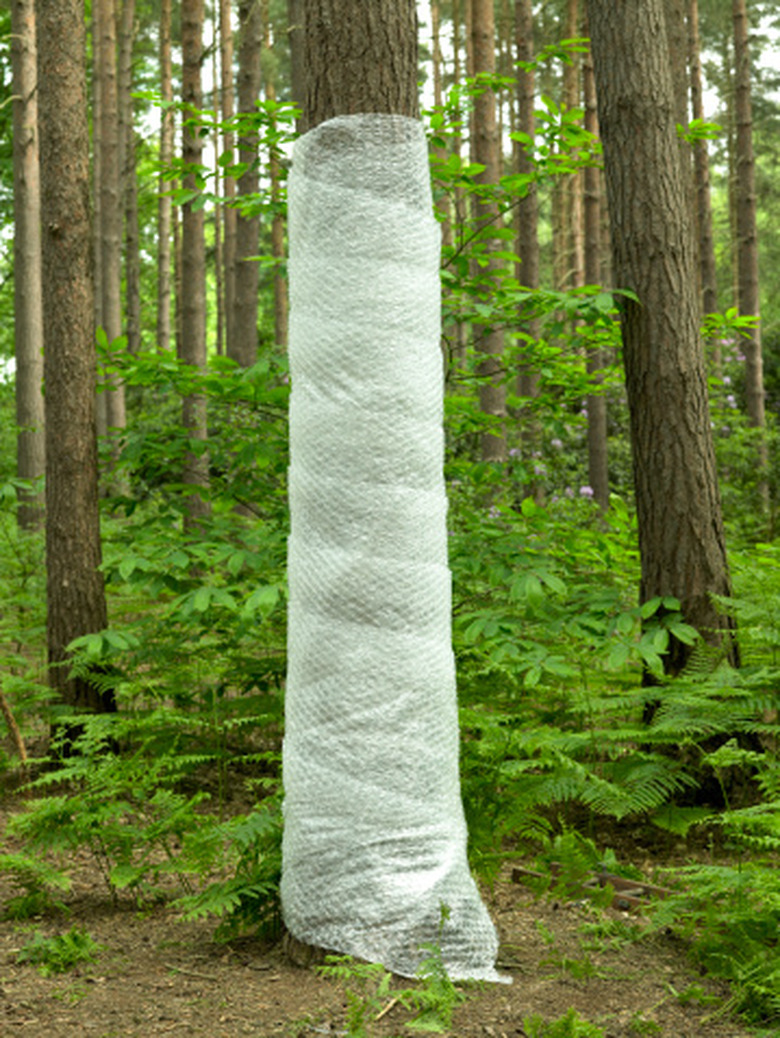What Do I Wrap A Tree With When The Bark Has Been Scraped?
If you're hoping to protect your damaged tree by wrapping it, then you're in for a big surprise. Wrapping is no longer recommended as a treatment for wounded trees. It actually does more harm than good. Your tree will be better off if you put down the wrap and pick up a water hose. Yep, a hose is the best thing you can do to help your tree heal from its injury.
Importance of Bark
A tree's bark protects it much like your skin protects you. Underneath the bark lies the vascular system. The vascular system carries nutrients and moisture to and from the roots and leaves. If too much of the vascular system is damaged, the tree starves to death. Bark also serves as a layer of protection from insects, diseases and animals. That's why smooth-barked trees are more prone to pest problems than trees with rougher, thicker bark.
- If you're hoping to protect your damaged tree by wrapping it, then you're in for a big surprise.
- A tree's bark protects it much like your skin protects you.
About Wrappings
Wrappings began as a method of protecting wounded areas from pathogens and insects, much like placing a Band-Aid on a wound. Instead, wrappings increased moisture underneath, which encouraged fungal and bacterial growth, especially if the tree was already wounded. Nor did the wrappings protect trees from insects. An experiment with dogwoods found more dogwood borers on trees covered with plastic guards than on trees without them, according to Deborah C. Swanson, an extension educator with the University of Massachusetts. The same goes true for similar treatments like wound dressings, latex paint and gluing or taping the bark back to the tree.
Other Treatments
Scribing, another recommended treatment for bruised or damaged bark, has also fallen out of favor, according to Dave Mooter, a community forester, and Michael Kuhns, an extension forestry specialist with Utah State University. Scribing is done by cutting a circular area around the wound with a sharp knife. It was believed to help promote healing and help the sap flow around the damaged area. In actuality, it only makes the wound larger.
- Wrappings began as a method of protecting wounded areas from pathogens and insects, much like placing a Band-Aid on a wound.
Recommendations
There is very little you can or should do once a tree has been damaged. Start by washing the wound with soap and water and then rinsing thoroughly. Let the wound air dry. Water your tree regularly during the summer and times of drought. This will minimize any water stress on the tree. You can also watch your tree closely for any signs of disease or pests. Don't fertilize it right away. Fertilizer causes new growth and uses energy the tree needs to use to healing.
- There is very little you can or should do once a tree has been damaged.
References
- University of Massachusetts Cooperative Extension; Recommendations for Planting...; Deborah Swanson
- Utah State University; Tree Injuries — Prevention and Care; Dave Mooter, et al.
- University of Kentucky; Don't Leap to Repair Freeze Damage in Landscape; Carol Spence
- Terry L. Ettinger Horticulture Consulting Services; Preventing Girdling Injury; Terry L. Ettinger
